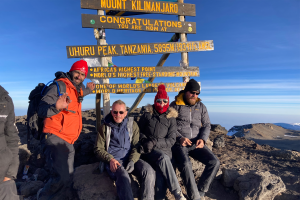The Difficulty of Climbing Kilimanjaro: A Comprehensive Guide
Kilimanjaro, the highest mountain in Africa, is a dream destination for many adventure seekers. However, climbing this majestic peak is no easy feat. The challenges of climbing Kilimanjaro are numerous and should not be underestimated. In this comprehensive guide, we will explore the difficulties faced by climbers and provide tips and strategies for conquering the summit.
Understanding the Challenges of Climbing Kilimanjaro
One of the main challenges of climbing Kilimanjaro is the altitude. At 19,341 feet (5,895 meters) above sea level, the air is thin and oxygen levels are low. This can lead to altitude sickness, which can range from mild symptoms like headaches and nausea to severe conditions like pulmonary edema or cerebral edema. It is important for climbers to acclimatize properly by taking their time and ascending slowly.
Another challenge of climbing Kilimanjaro is the unpredictable weather. The mountain has its own microclimate, with temperatures ranging from hot and humid at the base to freezing cold at the summit. Climbers should be prepared for all kinds of weather conditions, including rain, snow, and strong winds.
The terrain on Kilimanjaro is also challenging, with steep slopes, loose rocks, and slippery trails. Climbers should be physically fit and mentally prepared for long hours of hiking each day. The trek can be grueling and exhausting, especially as you near the summit.
Tips and Strategies for Conquering the Summit
To increase your chances of successfully reaching the summit of Kilimanjaro, it is important to be well-prepared. Here are some tips and strategies to help you conquer the mountain:
-
Choose the Right Tour Operator: Climbing Kilimanjaro is not something you should attempt on your own. It is essential to book a guided tour with an experienced operator like Sunset Africa Safari. They will provide you with knowledgeable guides, porters, and a well-planned itinerary to help you reach the summit safely.
-
Train and Get Fit: Climbing Kilimanjaro requires a good level of physical fitness. Start training months in advance, focusing on cardiovascular exercises, strength training, and hiking with a loaded backpack to simulate the conditions on the mountain.
-
Pack Wisely: Make sure to pack the right gear for your climb, including warm clothing, a sturdy pair of hiking boots, a sleeping bag, and plenty of snacks and water. It is important to stay hydrated and nourished throughout the trek.
-
Listen to Your Body: Pay attention to how your body is feeling and don’t hesitate to communicate any concerns with your guide. It is important to take breaks when needed and rest if you are feeling unwell.
Climbing Kilimanjaro is a challenging but rewarding experience. By understanding the difficulties of the climb and following these tips and strategies, you can increase your chances of reaching the summit successfully. For booking requests, contact Sunset Africa Safari at info@sunsetafricasafari.com.


